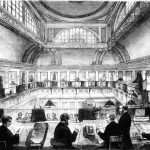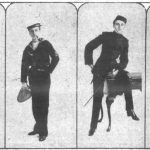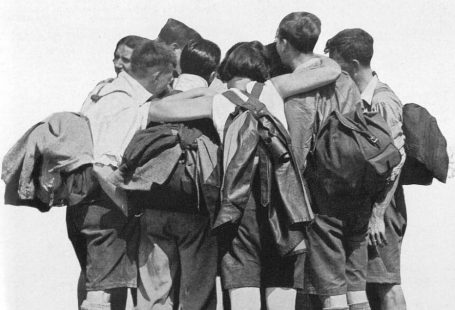This week at The Archive we have added a century’s worth of news, spanning the headlines from 1864 to 1964. We have added 90,176 new newspaper pages in all, with six brand new titles joining us from England and Wales over the past seven days.
So read on to discover more about our new titles, from Hastings to Harborne, from Neath to Stockton, as well as to find out which of our existing titles we have updated during the past week. Using our new pages, we will also delve into the history of the bachelor girl, an early twentieth century phenomenon of the girl about town.
Register now and explore the Archive
So without any further ado, let’s take a turn about our new newspaper titles. First up is the Dewsbury Chronicle and West Riding Advertiser. This West Yorkshire-based newspaper was founded in the market town of Dewsbury in 1854, and circulated in the town, as well as Leeds, Huddersfield, Bradford, Halifax, Wakefield, Batley and ‘generally throughout the [West] Riding.’
Dewsbury Chronicle and West Riding Advertiser | 21 January 1881
Claiming to be the ‘only Conservative Newspaper for a population of 200,000,’ it was also the only newspaper at the time to be printed in the town of Dewsbury.
For our next new newspaper we take a trip across the Pennines to introduce the Formby Times. Published in the scenic coastal town of Formby, which was historically a part of Lancashire, the Formby Times was originally known as the Formby Times and Ainsdale and Altcar Advertiser, appearing weekly at a cost of one penny.
In 1895, the Formby Times had a guaranteed circulation of 1,000 copies, and featured sections like the ‘History of Formby,’ local news column ‘Formby Points,’ as well as containing ‘General News.’ The newspaper also ran prize competitions for short stories and sketches.
Our next new newspaper of the week is the Harborne Herald. This neutral title was published every Saturday at the cost of one penny in Birmingham, and claimed to be the ‘most influential paper in the district.’ Circulating in Harborne – ‘one of the most populous and important suburbs of Birmingham’ – and ‘in the populous Districts on the confines of Birmingham, comprising Edgbaston, Smethwick, Selly Oak, Bartley Green, Woodgate, Quinton, Beech Lanes, California and Northfield,’ the newspaper was also ‘sent gratuitously to many libraries, hotels and places of resort in the neighbourhood of Birmingham.’
Harborne Herald | 5 January 1884
Having the ‘advantage of being more carefully perused and less hastily thrown aside’ than other newspapers, the Harborne Herald contained sections like ‘General Gossip’ and ‘Topics of the Day.’ Featuring local news from Harborne and other Birmingham suburbs, it also featured news from further afield, from the rest of the country and abroad.
We move to the south coast of England for our next new title – the Hastings & St. Leonards Times. First published in the historic East Sussex town of Hastings on 20 October 1877, this Liberal title circulated in ‘Hastings, St. Leonards, and the district.’ A ‘well-arranged paper,’ its ‘local and district intelligence [was] full and complete.’ Priced at one penny, and appearing every Saturday, it claimed to be the ‘Largest Liberal Paper in East Sussex’ with a guaranteed circulation of 3,000.
In presenting the first edition of the newspaper to the public, its inaugural editorial states that the publication will be a ‘Hastings paper for Hastings people’ and that ‘The true interest of the town will never be out of mind.’ It also laid out the following intentions for the new title:
One of our main objects is to advance the cause of Liberalism. This we shall endeavor to do by advocating progressive and Liberal principles…The ‘Times’ will be a family paper. Its character will be such that it may lie on any table and be read with safety by the sons and daughters of our most carefully trained families.
Hastings & St. Leonards Times | 5 April 1890
As well as being a ‘family’ newspaper, the Hastings & St. Leonards Times also intended to be a paper for ‘residents and visitors,’ as well as for the ‘working man.’ To the former end, it included a section entitled ‘Fashionable Intelligence,’ which listed the latest arrivals in and visitors to the town. The newspaper also contained international news, ‘Local Jottings,’ and ‘County Notes’ from the nearby towns of Worthing, Lewes, Battle, Brighton and Ore.
Our penultimate new title this week hails from Wales – the Neath Guardian. First published in the Glamorgan town of Neath in 1926, this weekly one penny newspaper featured the news from Neath, Briton Ferry, Skewen and the communities of the Neath and Dulais valleys.
A lively newspaper, it featured local news sections entitled ‘Around the Districts’ and ‘Occasional Notes,’ as well as regular sections like ‘The Editor’s Bookshelf,’ featuring recommended reading and ‘Wedding Bells,’ featuring the local wedding news. The Neath Guardian also had a focus on all things motoring – with features like ‘Neath Motor Notes’ and ‘Neath Motor Club.’ It had compelling articles such as this one, entitled ‘The Seamy Side – Recollections of a Prison Doctor,’ as well as a ‘Woman to Woman’ section, with fashion tips and household advice. Finally, you can find within its pages a ‘Cookery Corner,’ as well as a sports’ page, which had a particular focus on rugby.
Neath Guardian | 19 September 1930
Our final new title of the week is the Stockton Herald, South Durham and Cleveland Advertiser. This Liberal title was first published in Stockton-on-Tees, County Durham, in 1857. Circulating in South Durham and North Yorkshire, it advocated ‘measures of general progress,’ as well as giving ‘reports of events occurring in the district’ with a special focus on the ‘staple occupations’ of the local area, those being agriculture, iron manufacture, mining and shipping.
Within its pages you can find serialized fiction, such as a story entitled ‘The Haunted Husband,’ as well as ‘Humorous Selections’ from the day, and recommended ‘Reading for Ladies.’
Aside from our new titles, we have also updated twelve of our existing titles. Of particular note are the over 8,000 new pages that we have added to the Torquay Times, and South Devon Advertiser, and the over 3,000 new pages that we have added to the Liverpool Daily Post. Full particulars of all the additions we have made this week can be found at the end of this blog.
The Bachelor Girl
Whilst delving through our new pages this week, we found the fascinating term ‘Bachelor Girl’ featured amongst them. This being the week that International Women’s Day is celebrated, and a month where we are featuring pioneering women from history across the Archive’s blog and social media channels, we’d thought we explore this term, which denotes a single woman earning her own keep, and living alone, a revolutionary concept in the early twentieth century.
Sheffield Independent | 23 October 1919
We find the term ‘Bachelor Girl’ mentioned as early as 1904 in the pages of the Torquay Times, and South Devon Advertiser. This article relates how:
The bachelor girl is going to be one of the most conspicuous features of the twentieth century. But that institution, like the century, is still young, and certain problems still confront it. Amongst them is the question, where and how shall the bachelor girl live?
The Torquay Times, and South Devon Advertiser, explores this question further:
She wants to make her own living, and she wants the social freedom enjoyed by the bachelor man. As a rule, neither of these two wants can be satisfied if she lived at home. Work lies in London, and home, it may be, is in the country. Moreover, the restrictions and conventions of home life war against the ideal of freedom.
But the Bachelor Girl, the newspaper suggests, would still ‘demand the comforts of home life,’ for ‘she is not so easily satisfied as her brother with the substitute of ‘diggings.” And as for landladies, where they are ‘freedom is not,’ whilst flats could be seen as something of a ‘luxury.’
The Bachelor Girl | Daily Mirror | 24 September 1931
Fast forward to the 1920s, when the idea of a Bachelor Girl was much more firmly entrenched in society, women having won the vote and also expanded their sphere from the domestic to the public. The working woman was now very much a reality, and our newspapers are full of advice as to how they could now make their own home.
The Neath Guardian, 4 February 1927, in its ‘Woman to Woman’ section, includes a feature entitled ‘Bachelor-Girl Comfort.’ It provides a solution to the problem posed over twenty years before in the Torquay Times, and South Devon Advertiser:
Sometimes when incomes are not very large, two or three [young women] ‘club together’ so that a little flat of two or three rooms can be ‘snapped up’ when opportunity comes. It may be just three rooms of the attic type at the top of a big house, not very suitable perhaps for a family with children, but just the thing for two or three girls who are out all day, and who with a little capital, and a good sense of the artistic, can turn the most unpromising rooms into a little realm of beauty.
Neath Guardian | 4 February 1927
The Neath Guardian advises the Bachelor Girl, ‘if funds run to it,’ to buy a telephone, for:
…the addition of the telephone is a great boon – the expense does not seem nearly as great when divided say between three, and the convenience of being able to ‘phone when one is kept late at the office, or when an unexpected engagement turns up, for ordering, making inquiries, etc. is an untold blessing.
Our newspapers are full of suggestions for the Bachelor Girl’s home. Prunella Gay, writing for the Torquay Times, and South Devon Advertiser, gives some further advice on furnishing the ‘Business Girl’s Sitting Room:’
Because a bed must be included in the room, I suggest it is worth while sporting a single divan bed which can be covered in blue material to match the walls, and act as a settee during the day, thus giving added seating accommodation. There must be one easy chair in the room.
Torquay Times, and South Devon Advertiser | 7 November 1930
The business girl will not want the trouble of lighting a fire after a day’s work – or the bother of cleaning the grate next morning – so I suggest, for economy and time saving, the installation of one those gas fires with a small grilling oven over it, specially designed for bed-sitting rooms. Not only can the griller be used to heat a chop but also to boil the kettle.
So whilst the Bachelor Girl was grilling pork chops in her bedsit, or decorating her new flat with her friends, she was also making great strides outside of the home. In November 1930 a ‘Bachelor Girl’s Exhibition’ was held at the New Horticultural Hall in London, as reports the Torquay Times, and South Devon Advertiser.
It reassures its readers that:
It is not intended as an anti-masculine demonstration but is being organised in a spirit of independence and no man will be admitted to the exhibition unless accompanied by a woman.
Opening the exhibition every day was to be ‘some notable member of the ‘bachelor girl’ community.’ One such ‘notable member’ was M.P. Margaret Bondfield, Britain’s first woman cabinet minister, who held the position of Minister of Labour (you can read more about Margaret Bondfield here).
Furthermore:
The exhibition will be mainly devoted to illustrating the domestic life of the ‘bachelor girl,’ and possibilities of making it more comforting and home-like. It is proposed to hold up the long, trailing evening dress to derision, in company with the crinoline and tight laced corset, as symbols of the unemancipated days of womanhood.
What is remarkable about the portrayal of the Bachelor Girl in our newspapers is not so much the revolution she was spearheading, in supporting herself and working outside traditional female spheres, but the concentration on how and where she is living. It is almost as if she is once again tied to the domestic; that the Bachelor Girl could be more palatable if she was presented in the home sphere, rather than the one in which she worked.
Torquay Times, and South Devon Advertiser | 26 August 1932
But still, this does not negate the revolution that she was leading, the complete disruption of the patriarchary that she was at the forefront of – holding up evening dresses to derision, and seeing for the crinoline and tight laced corsets for what they were, ‘symbols of the unemancipated days of womanhood.’
New Titles
Title |
Years Added |
| Dewsbury Chronicle and West Riding Advertiser | 1882 |
| Formby Times | 1895, 1900-1906, 1908-1909, 1911, 1919-1922, 1930, 1933-1939, 1943-1951, 1967-1974 |
| Harborne Herald | 1877, 1879, 1883-1891, 1893-1895, 1897-1899 |
| Hastings & St. Leonards Times | 1877-1896, 1898-1899 |
| Neath Guardian | 1927-1964 |
| Stockton Herald, South Durham and Cleveland Advertiser | 1895-1896, 1898-1909, 1912-1918 |
Updated Titles
This week we have updated twelve of our existing titles.
You can learn more about each of the titles we add to every week by clicking on their names. On each paper’s title page, you can read a FREE sample issue, learn more about our current holdings, and our plans for digitisation.
Title |
Years Added |
| Blandford Weekly News | 1885, 1887 |
| Bridgend Chronicle, Cowbridge, Llantrisant, and Maesteg Advertiser | 1880-1883, 1885-1888, 1890-1891, 1894 |
| Faversham Times and Mercury and North-East Kent Journal | 1864 |
| Haslingden Gazette | 1913 |
| Liverpool Daily Post | 1901 |
| Nelson Chronicle, Colne Observer and Clitheroe Division News | 1890-1891, 1894 |
| Penistone, Stocksbridge and Hoyland Express | 1920, 1922, 1930-1931 |
| Ripon Observer | 1902-1903 |
| St. Helens Examiner | 1881-1882 |
| Torquay Times, and South Devon Advertiser | 1911, 1921-1933 |
| Weekly Dispatch (London) | 1940 |
| Wolverhampton Express and Star | 1899, 1911 |
You can keep up to date with all the latest additions by visiting the recently added page. You can even look ahead to see what we’re going to add tomorrow.
















